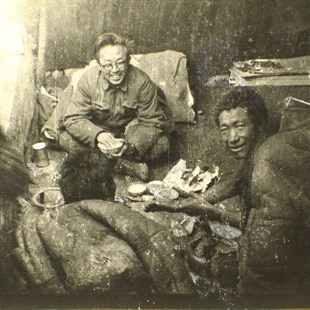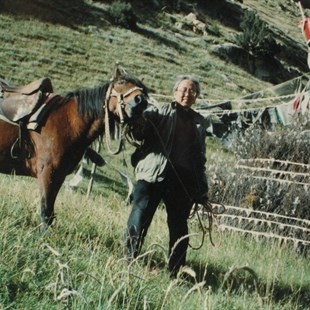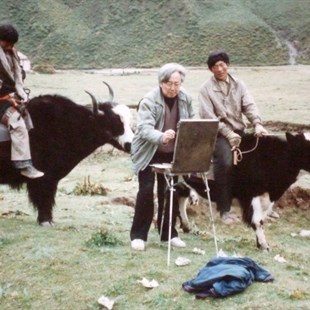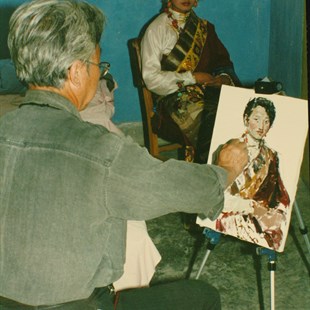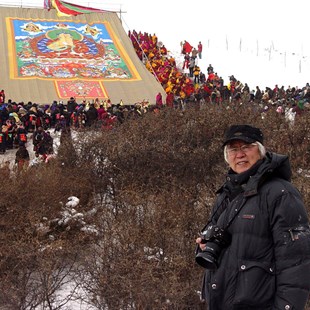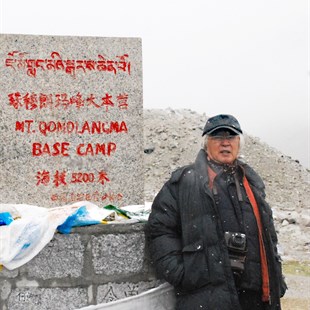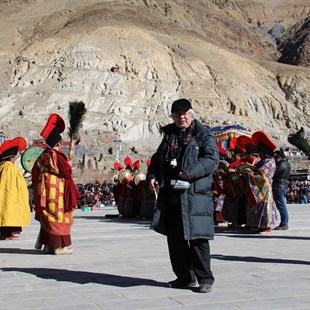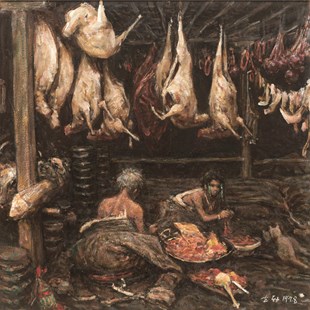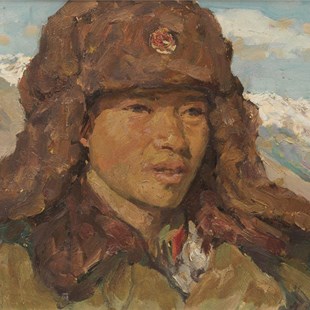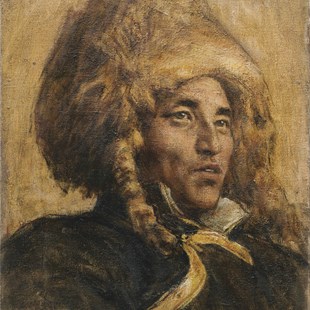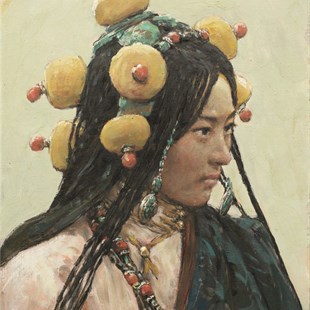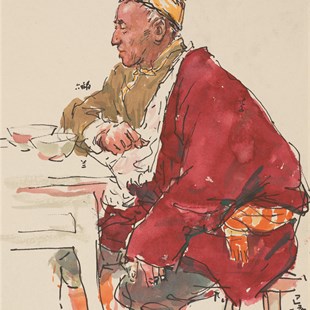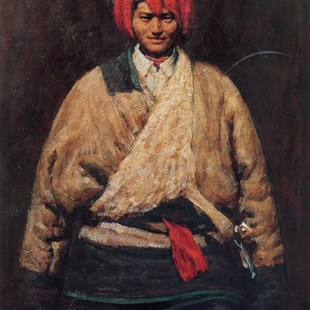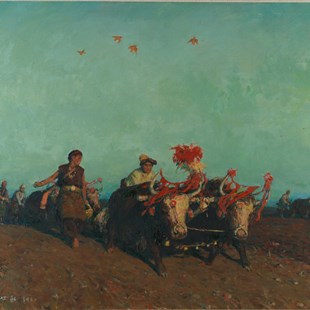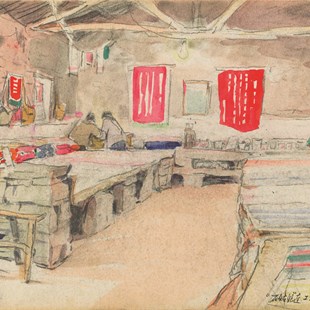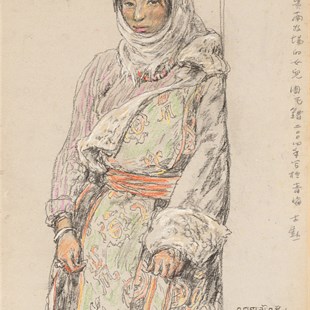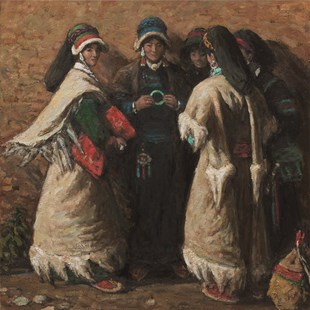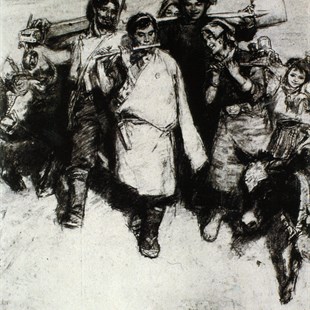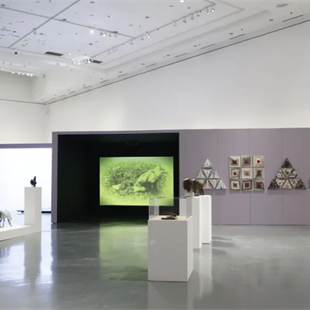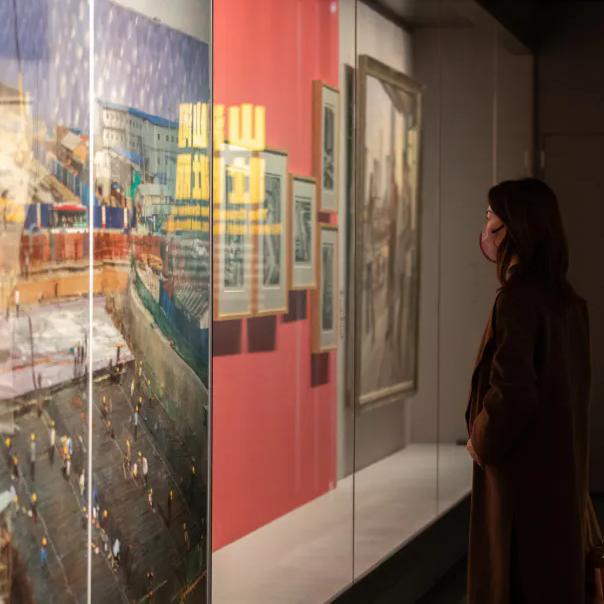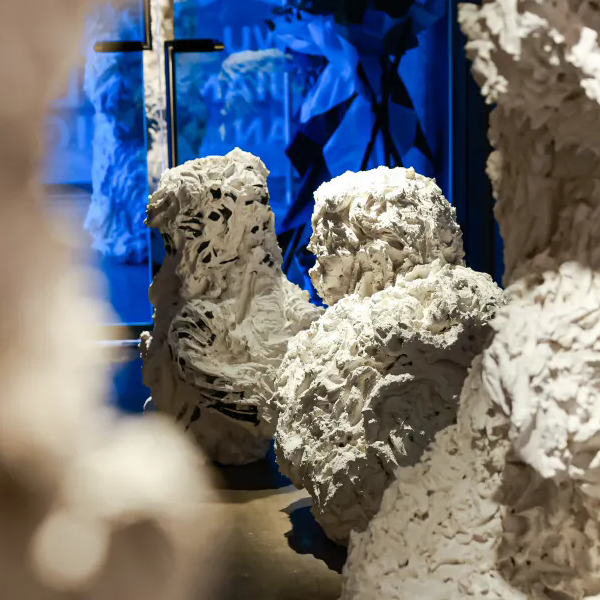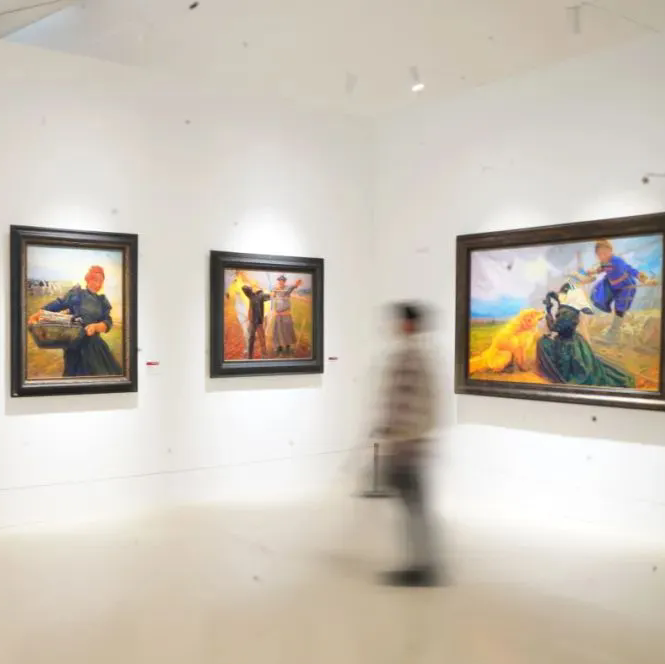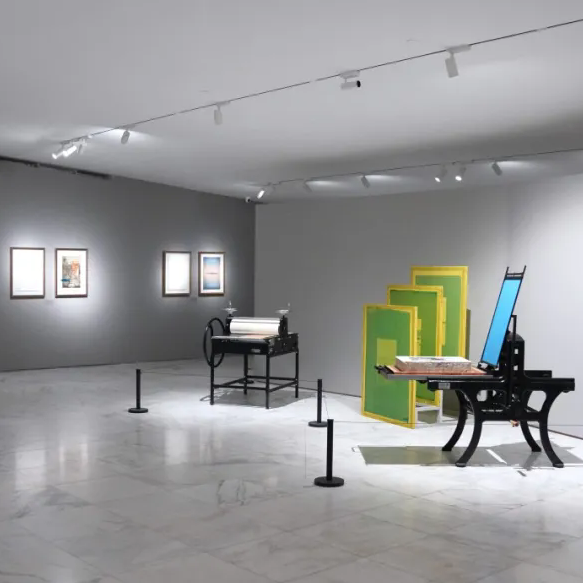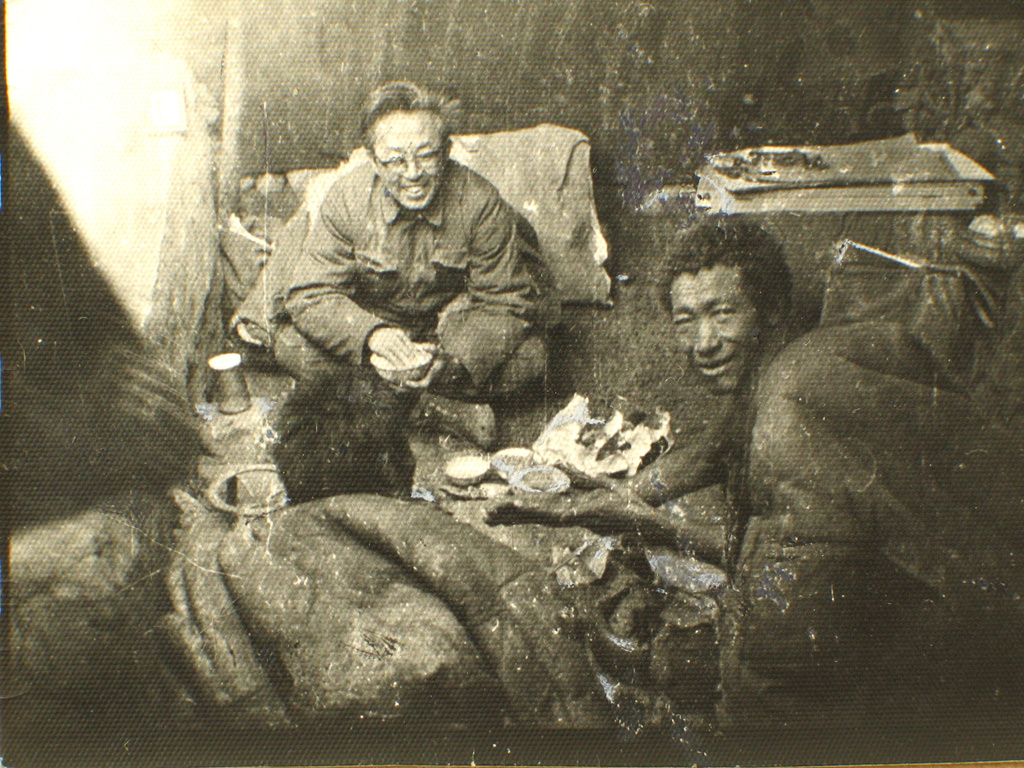
As the Central Academy of Fine Arts entered a new century in 2019, a senior artist of CAFA told us his story of going to Tibet fifteen times to paint, and this artist is Mr. Pan Shixun. Pan Shixun is an important oil painter and art educator in the history of Chinese modern art. He was once the Director of Department of Oil Painting of CAFA. The exhibition“Seeking Truth through Toughness, Taking the Truth as a Teacher—Pan Shixun’s Sketches and Oil Paintings” was recently held at the CAFA Art Museum. The exhibition was sponsored by the Central Academy of Fine Arts and was organized by the CAFA Art Museum and Department of Oil Painting of CAFA. This exhibition not only arouses spectators’ interest in the story of Mr. Pan Shixun’s entry into Tibet but it also reveals his research and presentations on the path to Chinese realistic oil painting since the 1950s and 1960s. Pan Shixun once served as the Director of Department of Oil Painting of CAFA. His artistic achievements also reflect the characteristics of China’s art education in the new era.
Pan Shixun was admitted to the Central Academy of Fine Arts in 1955. He joined the Department of Oil Painting in 1958 and studied under the guidance from Wu Zuoren and Ai Zhongxin. After graduating in 1960, he stayed on at school to teach. In the first half of 1960, he entered Tibet for the first time, sketching and collecting inspiration. Perhaps it is a coincidence as Mr. Wu Zuoren, Pan Shixun’s mentor, was one of the first Chinese artists to go to Tibet and paint a picture of it and in 1946 created the work “Tibetan Girl Bearing Water”. After the founding of the People’s Republic of China, Dong Xiwen, Ye Qianyu, Wu Guanzhong and other artists all went to Tibet to create art. To some extent, paintings on Tibetan subjects reflect the important characteristics of Chinese modern and contemporary art.
The exhibition is divided into three thematic units, each of which is based on the poems of Lu You, Pan Shixun’s favorite poet. The first unit is “There Was No Poetry without Visiting Xiaoxiang”; the second is “Eventually A Guest Everywhere in the World”; the third is “Natural Beauty without Cutting Out”. Works in each of the three units bring together the content and characteristics of Pan Shixun’s art and together form a true artistic portrait of Mr. Pan, who is 85 years old. Taking the truth as a teacher, Tibet, sketches, materials, techniques, etc.—these are the keywords and core values leading to an understanding of his work.
I. Realism Painting and Sketching: There Was No Poetry without Visiting Xiaoxiang
In 1982, Mr. Pan Shixun quoted Lu You’s poem as a summary of his
personal creative style in the opening chapter of “Answer a Friend on
Getting Deeper into Life”. This poem is a good expression of Pan
Shixun’s attitude and approach to art. In the historical era, taking the
real objects of life as the source of learning and recording them
truthfully is the most moving artistic expression. For Pan Shixun, the
reality is not just as simple as realism. He once said: “Truth is not
only about the trueness in paintings, but also about conveying the
beauty and touching things in life.” 1 Realism needs to convey feelings
of beauty and a sense of being touching. This is also what he insists on
in his specific painting practice.
In the numerous sketches that he was deeply involved in life, in addition to the accurate depiction of movements, the characters in a large number of sketches show a study of costumes and facial expressions and reflect the same working scene from different angles. In this exhibition unit, Pan Shixun’s sketches piece together his artistic trajectory, from the lines of pencils to the ink lines of pens to the colored brushes, showing the changes and the essence of sketches. If we look at them from this theme, the sketches of this unit can be divided into northern life, plateau life and southern life. The exhibition text introduces the fact that this is a seemingly rude but also mysterious arrangement. Through different humanistic and geographical features of the North and the South, we can show different styles and expressions with meticulous and strong characteristics.
Introduced in this exhibition is the sketch “Army” which is a teaching sketch. Because Pan was a soldier when he was young and received strict military training, his sketches often reflect all aspects of life in the army at that time. Especially during the actual combat exercise of the army, more than 60 sketches were drawn from various subjects a day. “Stone Girl” is a series of sketches by Pan Shixun in Hui Country in the 1970s, depicting the “Stone Girl” team building the Hui Country Reservoir.“Stone Girl”is a typical representative of rural girls in the 1960s and 1970s. This group of works vividly portray their valiant and graceful attitude in building the water reservoir in Hui County. From these sketches, you can feel that he has a deep experience of rural life in the north.2
II. Tibet: Eventually A Guest Everywhere in the World
Tibet is a paradise for tourists, but to Pan Shixun it is a temple of art. During the 15 expeditions to Tibet, he also developed a unique feeling for Tibet and it became an indispensable part of his art afterwards. For Pan Shixun, the earliest passive choice has become a favorite thing to do, eventually as a guest everywhere in the world. In Pan Shixun’s Tibet-themed works, there isbeautiful scenery as well as dazzling fireworks in front of him. The mysteries and realities of Tibet are unveiled one by one by his brushes.
Pan Shixun first entered Tibet during the first six months of 1960 and went there for the fifteenth time in 2016. In more than 50 years of painting and sketching from Tibet, Pan Shixun also recorded the years of change and development in the region. The earlier works paid more attention to the new life of the people in Tibet after liberation. They focused on expressing the new changes in the lives of ordinary herders in Tibet. The composition of the works highlights a classical visual harmony and romantic feelings. “Turnover Anthem” and “Red Sun Has Just Risen” are his first works after sketching in Tibet. “Turnover Anthem” was created with charcoal, but the structure of the picture is very prominent. The characters are mainly in the upper half of the picture and a third of the space below is left blank. In the center of the picture is a Tibetan young man playing the flute. Behind him is a group of farmers who have obtained land and are going to work in the morning. A bird also appears in the lower right corner of the picture joining in with the singing of the farmers. This work is not a sketch from life, but a sketch based on memory after returning from Tibet. But it is still a documentary sketch.
In the early days when arriving in Tibet, Pan Shixun participated in the democratic reform work in a small village in Shigatse, eating, living and working in the homes of poor herders. He had deep feelings when hearing about many social conditions of the old Tibet and witnessed new changes in life. But he couldn’t sketch at that time, he completed a set of documentary sketches after returning to Beijing based on memory and a few draft sketches. Because he painted people who had been with him every day, there is no lack of real emotions despite the haste. 3
“Red Sun Has Just Risen” is the most important oil painting representative of Pan Shixun’s Tibet series. The title of the work perfectly illustrates the value of this thematic creation. The design-oriented composition gives the picture a sense of order, in the way that people can feel that Tibetan farmers after liberation proceed in an orderly manner under the new system, having new production and life. The yellow land and soft blue-green divide the picture into two parts. A farming group comes from the picture, and the horns of the yak were decorated with red ribbons, which undoubtedly resemble the joy of the farmers. Four cheerful birds are leaping in the soft-colored sky and they also fly to the Tibetan herders yearning for a better life.
With the changes and development of Tibet, the theme and content of Pan Shixun’s works also changed. There was an increase in Tibetan herders’ life depictions and portraits, and the colors of the pictures highlight the atmosphere of that time, bright with a sense of peace and stability. Pan Shixun’s portrayal style of Tibet has come from the romantic style that first sought dynamics in stable colors, to the classical style that sought stability in vibrant colors. Living and working with Tibetans for a long time made him fall in love with the land. He once said, “although I first entered Tibet due to a historical ‘accident’, the later encounters tied me to this land.”4
III. Materials and Techniques: Natural Beauty without Cutting Out
Pan Shixun stayed on to teach after graduating from the Central Academy of Fine Arts. In the process of taking over the academic teaching of oil painting, he devoted all his attention and love to the cause. Pan Shixun’s contribution to oil painting is mainly reflected in two aspects: teaching and research.
In terms of teaching, he has trained a large number of oil painting talent for China with decades of teaching. On the other hand, in the 1980s, he went to France for study exchange. He was the first person to introduce courses related to techniques and materials of western oil painting into the teaching of oil painting in the New China. He was keenly aware that the simplistic understanding of techniques and materials in China restricted the further development of Chinese oil painting, so he organized and promoted classical oil painting techniques such as the Tempera technique and indirect painting techniques from overseas, and proposed “fat over thin” and other concepts and rules that have become common in today’s oil painting practice. He pioneered the establishment of techniques and materials studios in Department of Oil Painting of CAFA (1994), which inspired the construction of related disciplines in many domestic institutions.5 Regarding the research of oil painting, Pan Shixun conducted in-depth research on the relationship between expression and techniques and materials, and emphasized that materials and techniques are to serve the theme. He also published research monographs such as “300 Pictures from the Evolution of Traditional European Painting Techniques”. Pan Shixun’s pursuit and exploration of oil painting underscore the unique temperament of an artist with a sense of mission.
Although the three keywords and three poems of Lu You allow viewers to perceive Pan Shixun’s artistic career quickly and clearly, viewers will not know Pan Shixun and his story of Tibet until they come face to face with the exhibition and the artworks.
Reference Materials: 1-5, Exhibition Text in Chinese.
Text by Lin Lu, translated by Yuting He and edited by Sue/CAFA ART INFO


